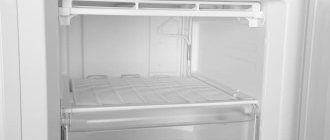The small size of the kitchen forces owners to look for options for placing large household appliances in other rooms. Most often it turns out to be a refrigerator, which is taken out into the hallway or into the next room. This causes a number of inconveniences: walking far to the place where food is stored, noise from a running compressor interferes with night rest. Some people decide to place the refrigerator on the balcony with access from the kitchen. This can be a good alternative, but subject to certain conditions. In the article we will consider the possibility of placing equipment on various types of balconies.
The principle of operation of the freezer
Each device has its own requirements for operating conditions. They also include location characteristics. To find out whether it is possible to place a refrigerator on a balcony, you need to understand how the cooling process occurs.
Components of a conventional refrigerator:
- A compressor is a piston mechanism responsible for moving refrigerant.
- Evaporator – located in the walls of the refrigeration chamber, it takes heat from it.
- Condenser – transfers heat to the outside, located at the rear of the unit.
- The refrigerant (most often freon gas) is distilled by a compressor through pipelines and delivers heat to the condenser from the evaporator.
When liquid freon enters the evaporator, it becomes gaseous. Its temperature readings become lower than those inside the refrigerator. Therefore, the freon heats up and the chamber cools. The refrigerant is then distilled into a cooler where it cools and returns to liquid form. After freon enters the evaporator, the entire cycle begins again. Freon moves until the desired temperature inside the chamber is reached.
Refrigerants can move stably through pipes at a certain room temperature. Manufacturers create models that operate stably under standard environmental conditions. If in the middle part of the country the temperature in a residential building ranges from +17 to +30℃, then refrigeration equipment for these regions will work properly at such indicators. For southern tropical countries, both the temperature and humidity at which the refrigerator can be used will be different.
Secrets of technology
The basis for the operation of any refrigerator is the principle of phase transition - the phenomenon of changing the aggregate states of substances (from gas to liquid and vice versa). The described physical process is accompanied by another phenomenon - the absorption or formation of a significant amount of heat. The operation of the refrigerator is based on a similar system; refrigerant (freon) is used as a liquid instead of water. In order to understand the effect of freon on cooling the contents of refrigerators, you should know its main characteristics.
- The boiling point of the refrigerant charged into the system is below zero degrees Celsius.
- The process of freon boiling is accompanied by the absorption of warm air from the refrigerator, creating an optimal temperature.
- Thanks to the presence of a compressor, at the next stage freon turns back into liquid.
- The heat generated in the process escapes through the back wall of the refrigerator (heat exchanger).
This is how a refrigerator works
Since the temperature of the living space is above zero degrees, ideal operating conditions for the refrigerant are created. Accordingly, the uninterrupted operation of refrigeration units is ensured by a positive temperature in the room.
It should be noted that manufacturers of modern household appliances have developed special systems in refrigerators that are capable of efficiently performing their functions in different climatic latitudes and temperature conditions.
Is it possible to place a refrigerator on the balcony in winter?
Balconies and loggias can differ greatly from each other in the degree of protection from external conditions. There are several main types; let’s take a closer look at the possibility of installing refrigeration equipment on them.
Balcony without glazing and insulation
Placing a freezer on an open balcony is strictly prohibited!
Placing equipment on such a balcony is the same as on the street. It has no protection from severe frost or heat, from precipitation, dust, as well as insects and rodents. All this will lead to the following problems with technology:
- Formation of rust on metal parts from contact with precipitation.
- Increasing load on the compressor will lead to early wear of the equipment.
- Violation of the appearance of the equipment body.
- Damage to the seal from temperature changes, heat and frost will result in the door not fitting tightly to the body.
- Risk of fire from short circuit due to moisture getting into the electronics of the refrigerator.
Corrosion process on the surface of the evaporator.
Glazed balcony without additional insulation
A closed loggia is a more suitable place to keep a refrigerator. Glazing prevents direct precipitation from coming into contact with equipment, but condensation often forms on uninsulated balconies due to temperature changes. Moisture can get on the body, wires, and electrical parts of the refrigerator. “Cold” glazing does not provide good sealing, which means that some dust and precipitation will get inside, especially in the wind.
Even if you provide waterproofing, it will be impossible to maintain a suitable temperature in extreme cold and heat. If the air is warmer or colder than the data specified in the data sheet, the refrigerator simply will not turn on.
Note! If the freezer turns off almost immediately after turning it on, the operating temperature conditions were probably not maintained.
If the summer is not very hot, then it is possible to use the refrigerator in spring - autumn, and store food in the off mode in winter. Refrigerators do not have a warming function, and if the room is very cold, the device will not be able to function.
Summary
From all of the above, we can conclude that it is not recommended to install the refrigerator on unglazed and unheated balconies. If the loggia or balcony has glazing, then for the normal functioning of the equipment you need to create all the conditions (installation of heaters, ventilation, protection from the sun, etc.), otherwise the refrigerator will quickly fail.
Please note: How to get rid of condensation on the balcony?
In addition, when installing a refrigerator on a balcony (on a balcony, not in a loggia), you need to take into account the strength of the load-bearing concrete slab (especially in old houses). It is quite possible that it is not designed for heavy loads. And glazing, finishing materials and supplied equipment will create a very significant load on the floor.
A fun way to use an old refrigerator. If you install the pipe on the side, you can also use a working refrigerator on a glassed-in balcony and turn it on only in the summer. Video below.
As an alternative to a regular refrigerator, you can consider purchasing soft thermal containers, which are great for storing vegetables, fruits and other products in winter. Such containers for storing vegetables are used in many countries around the world.
https://www.youtube.com/embed
Is it possible to put a freezer on the balcony?
The conditions for placing a freezer on the balcony in winter are generally the same as for refrigerators. But there are nuances. The average temperature inside the chamber is -18℃. For the equipment to work, the air outside must be 2-3 degrees warmer. At -16℃ the device will work, but at maximum power. This will lead to rapid wear of the compressor and breakdown of the cooling system.
Important! Violation of the rules for operating devices specified in the instructions is grounds for refusal of free repair.
Whether to install a freezer on an insufficiently protected and insulated balcony is up to each owner to decide for himself. But it is important to understand what problems this can lead to. In addition to equipment failure, there is a risk of causing inconvenience to neighbors. Vibration from a working refrigerator can be transmitted along the walls and be felt by residents as a constant hum.
Among all types of balconies, the only suitable option for placement is a glazed, insulated loggia. But it is equally important to choose the right equipment model.
Basic requirements for the premises
In order to finally understand where it is permissible to store and efficiently use the functions of refrigerators, it is worth finding out the main requirements for the premises. There are few rules and they are all important.
- The best option is frequently ventilated rooms.
- The refrigerator will be uncomfortable in direct sunlight (danger of freon overheating, a direct path to system failure).
- Humidity is below 80 percent.
- It is important to protect household appliances from precipitation.
Conclusion: refrigerators can be stored on loggias with above-zero temperatures, protected from rain and snow.
There are a number of nuances that should be taken into account when placing the refrigerator on different types of balconies.
Loggia room
Many owners expand the living space of the apartment by adding a loggia to the room. Typically, balconies-rooms (insulated) are the best choice for placing a refrigerator. The only problem is the lack of an outlet on the balcony premises: according to the rules for the safe operation of loggias, it is prohibited to conduct electricity there. Therefore, you will have to buy an extension cord in order to connect the equipment to the network using a room outlet.
Glazed option
Glazed loggias are:
- insulated;
- not insulated.
Choose the darkest place for your refrigerator
Glazed balconies with an entrance to the kitchen differ from attached balconies in that they do not have the status of a living space; it is colder on the loggias than inside the apartment. The refrigerator runs smoothly and stays warm. Therefore, if the loggia is not insulated (16-32 degrees Celsius), breakdowns may occur in the refrigerator, particularly in winter.
To avoid such troubles, there are several practical recommendations. Firstly, use the refrigerator on the loggia only during warm periods, and store food in winter without using household appliances. Secondly, move the refrigerator into the apartment for the winter months. The third option is to provide heating for the balcony room.
The presence of an insulated loggia “on-site” eliminates a number of the problems described above: in a heated room, the air temperature remains pleasant to the refrigerator at all times.
Without "glass"
It is better not to keep equipment on completely open balconies. There is a rational explanation for this:
Homemade refrigerator for the balcony
- the balcony does not protect from direct rays of the sun, precipitation, wind;
- manufacturers refuse warranty service for equipment used outdoors;
- sudden changes in temperature conditions and humidity significantly accelerate the period of wear of the unit;
- the anti-corrosion coating deteriorates quite quickly in “open” conditions;
- rubber parts lose elasticity.
If the owner values the equipment, it should not be exposed to the sun or rain or snow.
What kind of freezer can be installed on the balcony?
Freezers differ in design solutions:
- Chests are a horizontally located chamber with a door on top. Inside the chest is divided into compartments.
- Cabinets are no different in appearance from refrigerators. They have a vertical arrangement, the door opens from the front.
The choice of model depends on personal preferences, the size of the loggia and the types of products that you plan to store frozen.
Whether a freezer will work on a balcony in winter depends on the region for which it was manufactured (climate class). For regions with a mild climate, where the temperature in winter does not drop below +12℃, class N models are suitable. Provided that the freezer is placed on a balcony with glazing and insulation.
Difficulties in operation
But even if the balcony is glazed, you may encounter certain difficulties when storing a refrigerator on it. First of all, it is worth remembering that low temperatures can make it difficult for the device to operate . First of all, it's a matter of the thermostat. If heat does not come from outside, then due to the cumulative effect, sooner or later the equipment may stop working.
If you plan to place a Soviet-style refrigerator on the balcony, then you will have to face new problems. This technique runs on semi-synthetic or mineral oil. And at low temperatures they simply thicken. This doesn't happen right away, but over time you will notice changes. When the oil thickens, the compressor operates at almost full capacity. But this power is not always enough, which is why the protective relay is triggered. It is also important to remember that the rubber of the seal also does not survive the cold well - at low temperatures it loses flexibility and can burst.
But these problems are completely solvable. Service technicians offer several ways to solve them. First of all, if you have nowhere to put the refrigerator and you want to place it on the balcony, you need to make sure that it is glazed . Ideally, you also need to insulate the balcony . After all, in winter the temperature can drop very much. And in this case, even window frames will not save you from the cold. Here you will need full insulation of both windows and walls.
Also check that the room humidity is not very low - this is also quite dangerous. In such a room, the wiring may short out, as a result of which the equipment will simply burn out.
Operating a refrigerator on a balcony should be treated with extreme caution. It is better not to put sockets there. The most convenient option is to use a carrier. You also need to be sure that all wiring is carefully insulated. After all, cracked ones can lead to short circuits.
You install a refrigerator on the balcony, as they say, at your own peril and risk. But if you have nowhere to keep it in your apartment or you want to take the equipment out during repairs, then this can be done. It is not recommended to place it on the balcony in winter, especially if it is cold and open.
Rules for installing and connecting the device
In addition to the temperature, humidity and strength of the balcony slab, the uninterrupted operation of the device is affected by proper installation and connection. These rules will help extend the life of the equipment and make the operating process safe:
- The base must be level and stable.
- The distance from the rear and side walls to the surfaces of the balcony must be at least 4-5 cm. This is necessary for sufficient air ventilation and to prevent overcooling of the device.
- It is not recommended to connect the device to the network through a carrying case. The outlet must meet all standards and be grounded.
- The device should not be located near batteries or heaters.
Wardrobe with built-in freezer for a heated balcony:
You can install the refrigerator on a glazed and well-insulated balcony. It would be good if it would be possible to additionally heat it in cold weather, as well as cool it in hot weather.
The technologies used in the latest models allow the device to operate even at ambient temperatures up to +5℃. At the same time, the load on all systems will be increased, which can lead to early wear of the equipment. Repair under warranty in this case is impossible, since the operating conditions were violated. If you have an old device, for which the warranty has long expired and you don’t mind parting with it if it breaks, then you can try placing it on the balcony. In any case, it is important to ensure fire safety and ensure the stability of the balcony base.
What do manufacturers recommend?
One of the important characteristics of a refrigerator is the climate class, which shows at what ambient temperature the normal operation of the unit is guaranteed . Manufacturers prescribe operating refrigerators in the temperature range from +16 to +32°C (normal climate class N). Some models can operate at temperatures from +10 to +43°C (universal climate class SN-T).
Failure to comply with these requirements may result in unstable operation of the unit . Moreover, if a breakdown occurs due to non-compliance with the recommended operating conditions, the manufacturer has every right to refuse you warranty repairs.
Important! Operating a refrigerator on an unheated balcony or loggia (even if it is glazed) will most likely lead to a violation of the temperature regime recommended by the manufacturer (in autumn, winter and spring the temperature may well be below 10 °C, and in summer it may exceed 40 °C above zero).
The main reasons why to use a refrigerator or freezer on the balcony :
- Exposure to precipitation on an unglazed balcony. When installing a refrigerator on an unglazed balcony, direct moisture on the unit threatens the electrical safety of the entire apartment: this can lead to a short circuit. In addition, in conditions of constant exposure to moisture, corrosion of metal parts is inevitable.
- High humidity. Operating a refrigeration unit in conditions of high humidity can lead to damage to electrical insulation, premature corrosion of metal parts of the refrigerator, swelling of the paintwork, etc. In addition, exposure to moisture can cause damage to the thermostat or control board of the refrigerator (due to oxidation of the contacts).
- Exposure to direct sunlight and high temperatures. Installing the refrigerator in an area exposed to direct sunlight will inevitably lead to fading of the paintwork of the unit - the paint will turn yellow and crack, and damage to plastic and rubber parts. In addition, in the summer, it is possible that the temperature at which the refrigerator can be operated is exceeded, which will force the compressor to work at its limit and may cause it to fail.
- Exposure to negative temperatures. During the cold season, the oil in the refrigerator compressor thickens, which puts additional stress on the motor and shortens its service life. In addition, at low ambient temperatures, the pressure in the line drops, and the freon collected in the condenser is initially unable to leave it. Therefore, the refrigerator motor will run idle for some time to create sufficient pressure. This also leads to overload of the compressor and premature failure.
Design Features
In a small modern apartment, every meter is valuable. Therefore, when an opportunity arises to save some space, everyone rushes to take advantage of it. And if you decide to move the refrigerator onto the balcony or turn the loggia into an extension of your kitchen, then it is not necessary to sacrifice the beauty of the room. As customer reviews prove, the design of a balcony with a refrigerator can be quite interesting.
An enclosed balcony can be turned into a kitchen workspace by installing a refrigerator, several cabinets and a table. This way it will be very convenient for you to cook. And in the kitchen itself you can install a table with chairs. This way you will have more free space for family lunches and dinners, as well as for gatherings with friends.
A refrigerator can fit quite organically into a kitchen set. It can be classic white or stylized as wood - in any case it will look organic and very beautiful.
Experts advise avoiding the proximity of a refrigerator to a gas stove, so it should be located in the kitchen. But this is still a fairly convenient option, especially if the balcony space is connected to the kitchen space.
If you like to stock up on frozen vegetables and meat for the winter, then on the balcony you can install not only a refrigerator, but also a large freezer. This way they will not take up free space in the apartment itself, and you will have a good supply of food.
In this video, the author will show you how you can wisely use the space on the balcony and correctly install a freezer in the closet.
In general, the refrigerator can be installed both on the balcony and on a simple loggia. The main thing is, before you take it out there, make sure that you can create normal conditions for storing and operating this equipment. This will extend its service life and ensure normal operation.
Install the equipment in a room with suitable conditions, and it will delight you for a long time with its high-quality work and neat appearance.










